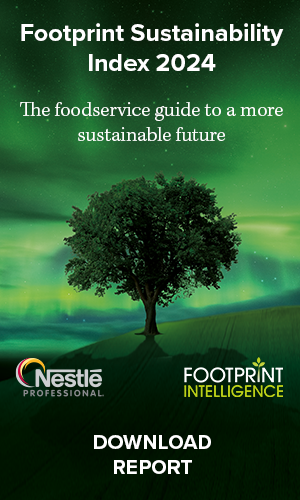Eco-labels are here to stay but the design of them is vexing foodservice brands, finds David Burrows.
The hype over eco-labels continues. Sky and Microsoft are both trialling concepts in their canteens, while WSH (Benugo) and Compass are also offering indicators on menus that show the environmental impact of the choices available. Wahaca, Leon, Ask Italian and Peach Pubs are among the high street chains to have also waded into the sticky concept of eco-labelling.
I say sticky for two reasons. One because if you start looking into this idea it’s hard not to be pulled in by its potential; and two because you can quickly become overwhelmed by data, metrics and boundaries. Some brands are therefore plumping for a carbon first approach in a bid not to confuse consumers. Others feel that applying more metrics to create a more holistic score is worth the pain if it helps consumers make more informed choices about the food they buy. Brands will certainly need to work even harder on blending the appeal of simplicity with the rigour of detail as these labels evolve.
Currently, there are a number of approaches and no right or wrong approach, as we discuss in Footprint’s latest report – A transparent future for foodservice. Rather, the activity and ambition shown by those who have begun to put scores and footprints on their menus should be applauded. Pioneers with their heads above the parapet risk being shot down but solutions, as Simon Heppner from Net Zero Now told us, will come through analysis, creativity and trial and error. “We should be cautious about creating a climate in which businesses feel unable to innovate,” he warned.
So we need constructive criticism on what’s out there, and what we are learning from all the activity. One area to watch closely is how these scores are designed. Almost a third (31%) of the consumers we asked in an exclusive survey by Vypr weren’t sure how they’d like the information presented to them. The most popular option was for some type of colour-coded label (33%) – unsurprising given familiarity with traffic light labels for nutritional content. But foodservice companies foresee an issue: a red score on certain dishes (notably red meat) will make people feel guilty when they are supposed to be out enjoying themselves.
Sirloin stigma
Consumer polls, including ours and a huge Eurobarometer one, show people are hungry for these labels but whether they can stomach the results remains to be seen. A 12oz sirloin steak at Peach Pubs for example comes with a footprint of 13.8kgCO2e – or three meal’s worth of what the WRI estimates to be the recommended daily allowance of carbon per meal in Europe (3.8kgCO2e). The dirty vegan burger has a much daintier footprint (0.9kgCo2e) and so too do the free-range chicken schnitzel (2.1kgCO2e) and the daily fish options (1.1kgCO2e).
Even if a label can persuade some consumers (research led by Bristol University suggests it’s the eco-conscious that are most malleable) to bypass beef, those other lower-carbon choices also come with baggage. These “tradeoffs” are described in recent research led by Anna Grummon at Harvard T.H. Chan School of Public Health in the US and published in the Journal of the Academy of Nutrition and Dietetics.
The team tested out different red meat reduction messages on menus relating to animal welfare (‘eating red meat contributes to animal suffering’, and ‘ethical eating can start with eating less meat’), health (‘eating red meat increases your risk of heart disease’, and ‘healthy eating can start with eating less red meat’) and the environment (‘eating red meat contributes to climate change’, and ‘sustainable eating can start with eating less red meat’). People were shown both the positive (in green font) and negative (in red font) messages. They found these showed “potential” to change consumer behaviours in full service restaurants with the health and environmental messages reducing red meat selection by 6 and 8.8 percentage points respectively versus the control. Animal welfare (somewhat surprisingly) didn’t have an impact.
But they also found that only the health message reduced calories and saturated fat selected from the hypothetical restaurant. What’s more, the health message simultaneously reduced selection of red meat and increased selection of poultry and fish. Although this substitution would likely reduce greenhouse gas emissions and improve health outcomes, there are animal welfare considerations (factory farming of chickens and overfishing). “The environmental message, by contrast, simultaneously reduced selection of red meat and increased selection of vegetarian items, suggesting a potential win-win-win for health, the environment, and animal welfare,” they wrote. Provided of course that the plant-forward option is healthier (processed meat alternatives are under scrutiny in this respect).
Finding harmony
There is certainly much more to learn about the power of eco-labels and the nuances of the nudges they enable. What information is presented and how is it presented are live (and fascinating) debates that our latest research dives into. Whether these labels should be mandatory (as The Behavioural Insights Team, formerly the government’s nudge unit, and the Skidmore net-zero review have both recently suggested) is also a priority discourse. There is fierce competition among the various schemes and data service providers but most see a transparent, collaborative and consistent approach as the end game. This is just the start but expect eco-labels to stick around.
Footprint’s latest report – A transparent future for foodservice: how environmental data is greening supply chains and empowering the public – is available free to download here.













